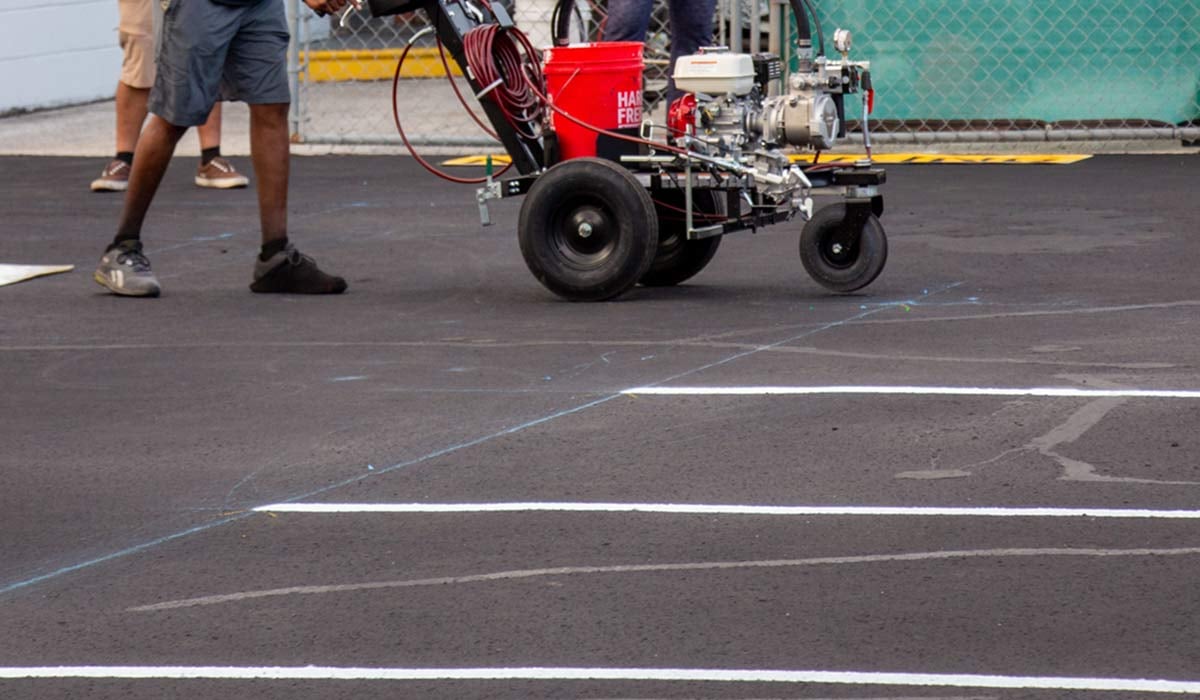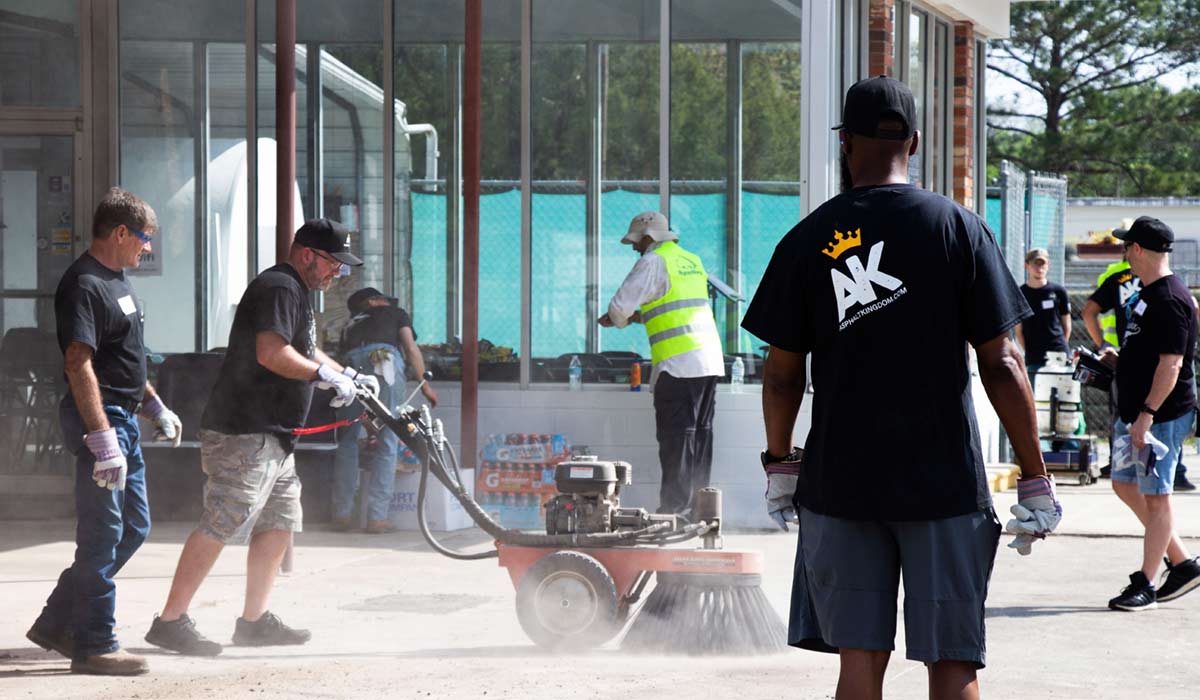Pavement markings are more than just paint on the road. They're a vital part of our transportation system, providing essential information to drivers and pedestrians alike. From dividing lanes to indicating crosswalks, they help organize and direct traffic, reducing confusion and preventing accidents.
A Safety Essential
Imagine driving on a busy highway without any lane markings. It would be chaotic and dangerous! Pavement markings are crucial for maintaining order and safety on our roads. They help us navigate through complex intersections, warn us of potential hazards, and ensure we stay within our lanes.
But pavement markings are not just about lines and arrows made with parking lot paints. They include a variety of symbols and signs that communicate important information to road users. From pedestrian crossings to bike lanes to parking areas, they play a critical role in ensuring the safety of all drivers and pedestrians.

Pavement painting with line striping machines
Types and Functions: Decoding the Language of the Road
Pavement markings come in many shapes and forms, each with its own specific purpose. Let's explore some of the most common types and their functions.
Line Types: The Basics
- Solid Lines: These indicate areas where passing or lane changes are prohibited.
- Dashed Lines: These suggest that passing or lane changes are allowed, but with caution.
- Double Lines: A combination of solid and dashed lines indicates that passing is allowed from one side but not the other.
Symbols and Colors: More Than Just Lines
- Crosswalks: Marked with white or yellow lines, these indicate where pedestrians have the right of way.
- Bike Lanes: Often marked with green paint, these designate a safe space for cyclists.
- Stop Lines: Thick white lines at intersections signal where vehicles should stop at a traffic light or stop sign.
The Power of Color
Colors play a crucial role in pavement markings. White is used for general traffic instructions, yellow for separating traffic moving in opposite directions, and other colors like green, blue, and red for specific purposes like bike lanes, handicapped parking, and emergency lanes.

Machines like the PowrLiner PL3500S Striping Machine
help make pavement markings
Safety Benefits: A Lifesaver on the Road
Pavement markings are not decoration. They have a profound impact on road safety, offering numerous benefits to drivers and pedestrians.
Enhancing Visibility and Awareness
- Daytime Clarity: Markings provide clear guidance, helping drivers navigate lanes and intersections.
- Nighttime Visibility: Reflective materials used in pavement markings shine brightly under headlights, aiding night driving.
Preventing Accidents and Confusion
- Lane Discipline: Markings keep traffic organized, reducing the risk of collisions.
- Clear Instructions: Symbols and signs communicate important information, preventing misunderstandings and dangerous situations.
Improving Traffic Flow and Efficiency
- Smooth Navigation: Well-marked roads keep traffic flowing smoothly, reducing congestion and delays.
- Quick Decision-Making: Clear markings help drivers make fast and safe decisions, enhancing overall traffic efficiency.
Regulatory and Standardization: Keeping It Consistent
To ensure the effectiveness of pavement markings, there are regulations and standards in place. These guidelines ensure consistency and clarity across different regions.
National and International Standards
- Uniformity: Standards like the Manual on Uniform Traffic Control Devices (MUTCD) in the US provide guidelines for pavement marking design and application.
- Global Guidelines: While specific regulations may vary by country, international standards aim to maintain a level of consistency in road markings worldwide.
Legal Implications and Compliance
- Safety Regulations: Road authorities are required to comply with standards to ensure the safety of road users.
- Liability: Failure to maintain proper pavement markings can lead to legal consequences, especially in the event of accidents caused by inadequate road markings.
RELATED ARTICLE: Parking Lot Line Striping
 Different road markings
Different road markings
The Future of Pavement Markings
The field of pavement markings is constantly evolving, with new technologies and materials enhancing their effectiveness and sustainability.
Advanced Materials: Durability and Visibility
- Reflective Paints: New formulations provide better visibility in low-light conditions.
- Durable Markings: Materials like thermoplastic and epoxy last longer, reducing the need for frequent reapplication.
Eco-Friendly Solutions: Sustainability on the Road
- Water-Based Paints: These reduce the environmental impact of road markings.
- Recycled Materials: Some markings are now made from recycled glass beads, contributing to a greener planet.
Smart Markings: The Road Ahead
- Temperature-Sensitive Paint: Changes color in response to weather conditions, warning drivers of icy roads.
- LED-Embedded Markings: Illuminate to enhance visibility and provide dynamic information to drivers.
Learn more about the PowrLiner PL3500S
Maintenance and Longevity: Keeping the Lines Bright
Regular maintenance is crucial to ensure that pavement markings remain effective over time. Here are some key aspects of maintaining these vital road safety features.
Routine Inspections: Staying Ahead of Wear and Tear
- Regular Checks: Authorities conduct periodic inspections to assess the condition of markings.
- Timely Repairs: Prompt maintenance is carried out to address fading, wear, or damage.
Preservation Techniques: Extending the Life of Markings
- Quality Materials: Using high-grade paints and materials ensures longer-lasting markings.
- Proper Application: Adhering to best practices in applying markings helps prevent premature wear. Plus, it helps that you have reliable and competent tools for doing road markings such as the Titan PowrLiner 3500 72V
Cost-Effectiveness: Saving Money and Lives
- Long-Term Savings: Investing in durable markings reduces the need for frequent reapplication, saving money in the long run.
- Safety Investment: The cost of maintaining pavement markings is far outweighed by the lives saved and accidents prevented. That is why we shouldn't take their maintenance for granted. The Titan LazyLiner Pro will make maintenance a breeze — even when you're sitting down.
Parting Words
Pavement markings are a critical element of our road safety infrastructure. They guide us, protect us, and help ensure a smooth journey for all road users. As we've explored, their benefits are immense, from enhancing visibility to preventing accidents and improving traffic flow.
Prioritizing Pavement Markings
It's time we recognize the importance of these markings and prioritize their maintenance and innovation. Investing in high-quality, durable, and eco-friendly pavement markings is an investment in our safety and the safety of future generations.
And speaking of maintaining pavement markings, here are some of the best line striping and painting equipment on the market today.
Embracing Innovation
Let's also embrace the advancements in pavement marking technology. From smart, responsive markings to sustainable materials, these innovations have the potential to revolutionize road safety.
A Shared Responsibility
Ensuring the effectiveness of pavement markings is a shared responsibility. Road authorities, drivers, and pedestrians all have a role to play in maintaining and respecting these vital safety features.
FAQ
Get answers to some frequently asked questions about pavement markings:
Q: How often should pavement markings be replaced?
A: The frequency of replacement depends on factors such as traffic volume, weather conditions, and the quality of materials used. Typically, markings on busy roads may need to be replaced every 1-2 years, while those on less-traveled roads may last longer.
Q: Are there different standards for pavement markings in urban and rural areas?
A: Yes, there can be differences in standards and requirements for urban and rural areas, reflecting the varying traffic conditions and needs. Urban areas may have more complex markings for bus lanes, bike lanes, and pedestrian crossings, while rural markings might be simpler but need to withstand harsher weather conditions.
Q: Can pavement markings be customized for specific needs?
A: Absolutely! Specialized markings can be designed for specific purposes, such as school zones, hospital areas, or areas with high pedestrian traffic. These customizations help address unique safety concerns and enhance the overall effectiveness of road markings.
Pavement markings are a vital part of our road safety ecosystem. By understanding their importance, maintaining their visibility, and embracing innovation, we can ensure that these humble lines continue to guide and protect us on our journeys.
Still have questions? Contact us or call our experts at 1-866-399-5562 for personalized advice!







